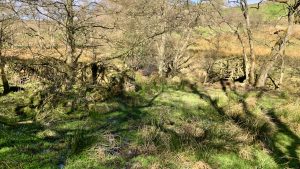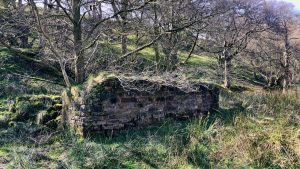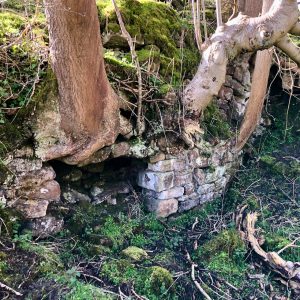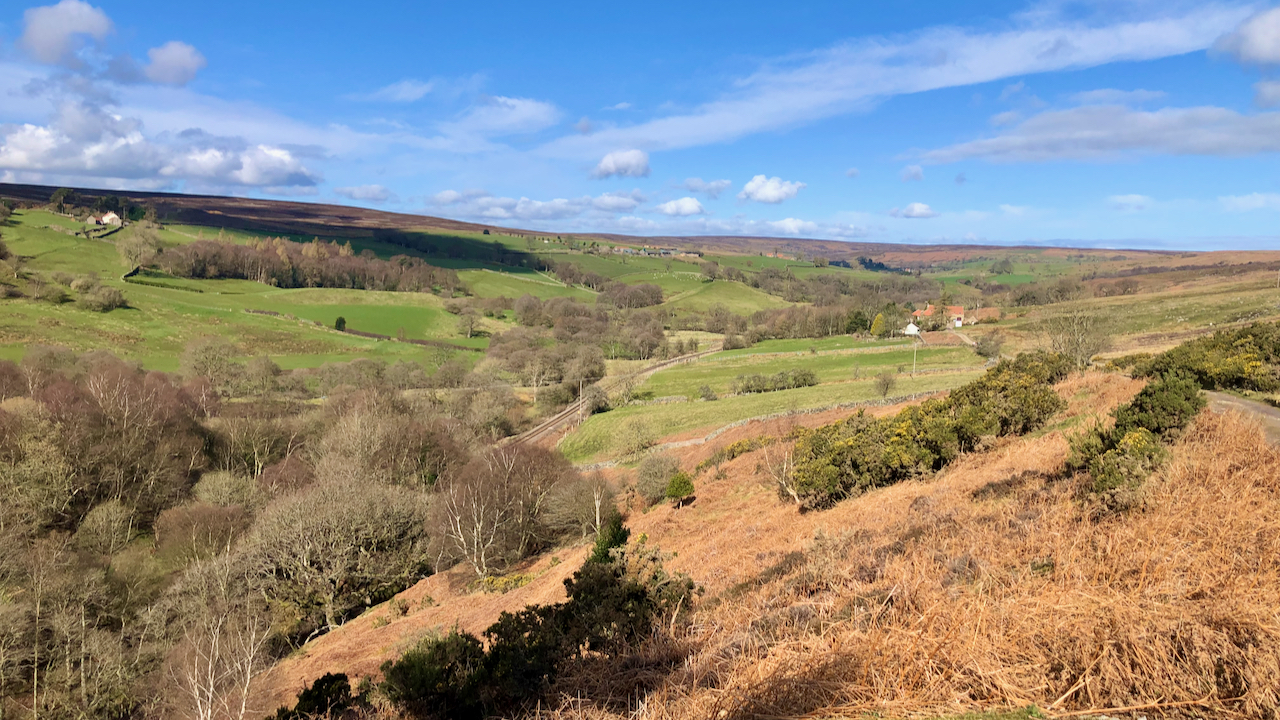Another item on my bucket list ticked off.
Commondale Beck is barely two miles long from its start at the meeting of Sleddale and Ravengill Becks to its confluence with the River Esk, although its meanderings might push it over this distance.

About 175 metres from Commondale Railway Station on the west Guisborough parish side of the beck, once stood a bleach and fulling mill1Ordnance Survey Six-inch England and Wales, 1842-1952. Yorkshire 30 (includes: Danby.) Available online at: https://maps.nls.uk/view/102344248#zoom=8&lat=5830&lon=3242&layers=BT [Accessed 8 Apr. 2022].. I have been curious to see what remains2NYMNPA HER Records (Monuments). Commondale bleach mill. HER No: 6705/11151/11511..
As it happens, there are some extant remains. Moss covered stone walls, a few courses high, a holloway and a stone trough, almost buried in the surrounding bog which dominates the site. The mill was demolished about 19103Millsarchive.org. (2022). Commondale Bleach Mill, Commondale – The Mills Archive. [online] Available at: https://new.millsarchive.org/mills/index/?action=show&which=11975 [Accessed 8 Apr. 2022].. But I guess it had fallen out of use long before that, probably when the railway came in 18614Wikipedia — Esk Valley line. Available online at: https://en.wikipedia.org/wiki/Esk_Valley_line#Grosmont_to_Battersby [Accessed 8 Apr. 2022]..

Maybe it never recovered from an ignominious fire which happened in heavy rain in 1824. Thomas Pickering was the miller at the time, and the rain leaked onto some unslaked lime. A severe chemical reaction occurred generating intense heat; “an outhouse with its contents, a cart, waggon, ploughs, &c. were all nearly destroyed“5‘LONDON’ (1824) Caledonian Mercury, 23 Sep, available: https://link-gale-com.ezproxy.is.ed.ac.uk/apps/doc/BB3205390664/GDCS?u=ed_itw&sid=bookmark-GDCS&xid=5bc62c9d [accessed 23 Jul 2021]..
Commondale lies partly in the parish of Guisborough and partly in Danby, Commondale Beck forming the boundary. Perhaps this was the underlying reason why a dispute occurred in the first decade of the 19th-century. The mill then was occupied by a John Saunderson (Sanderson?) who accused Henry Mills of “diverting the water of certain springs from a rivulet called Commondale Beck; to the prejudice of [his] mill“6A codicil to the will of Sir Soulden Lawrence | The News (London) | Sunday 24 July 1814 | British Newspaper Archive. [online] Available at: https:// www.britishnewspaperarchive.co.uk/viewer/bl/ 0002257/18140724/021/0007 [Accessed 2 Apr. 2022]..

Such disputes were not uncommon where there were many demands on a limited resource, in this case water. However what Henry Mills did to divert the beck is not clear. There was a corn mill upstream on the tributary of Sleddale Beck, but it is unclear if this was still in use at the time7NYMNPA HER Records (Monuments). Commondale corn mill. HER No: 6612/6614.. There is also the brick and tile works. This is generally said to have been founded in 1860 by John Slater Pratt but the 1853 Ordnance Survey shows a significant works already in existence8Ordnance Survey Six-inch England and Wales, 1842-1952. Yorkshire 30 (includes: Danby.) Available online at: https://maps.nls.uk/view/102344248#zoom=7&lat=6774&lon=2626&layers=BT [Accessed 8 Apr. 2022].. Perhaps the clay deposits have long been utilised.
In March 1809, the dispute between Saunderson and Mills ended up in court, in the Court of Common Pleas in York. Mills won although in a “subsequent” brought for the diversion of the water, Saunderson’s “right the use thereof was established“.
The case was before Sir Soulden Lawrence, a pre-eminent lawyer who had served for fourteen years in the King’s Bench trying criminal cases9Cam.ac.uk. (2022). Sir Soulden Lawrence (1751-1814) | StJohns. [online] Available at: https://www.joh.cam.ac.uk/library/special_collections/ early_books/lawrence.htm [Accessed 2 Apr. 2022].. In 1808, he returned to the Court of Common Pleas, for civil cases, and, in March 1809, was in York trying the Saunderson vs. Mills case10A codicil to the will of Sir Soulden Lawrence | The News (London) | Sunday 24 July 1814 | British Newspaper Archive. [online] Available at: https:// www.britishnewspaperarchive.co.uk/viewer/bl/ 0002257/18140724/021/0007..
The case must have hung heavy on Lawrence’s heart. Perhaps he felt he had erred or that justice had not been done. For, before he died in 1814, Lawrence created a codicil to his will instructing his executors to find and reimburse those persons who had paid Saunderson’s costs for him which he understood would not exceed £20, a considerable amount at that time11A codicil to the will of Sir Soulden Lawrence | The News (London) | Sunday 24 July 1814 | British Newspaper Archive. [online] Available at: https:// www.britishnewspaperarchive.co.uk/viewer/bl/ 0002257/18140724/021/0007 [Accessed 2 Apr. 2022]..
Incidentally, after his return to the Court of Common Pleas, Sir Soulden Lawrence still presided in the York Assizes. In the same month, March, 1809, those tried before him included Mary Bateman, the notorious Yorkshire witch accused of poisoning Rebecca Perigo12List of prisoners at York assizes — March 1809 | Leeds Intelligencer | Monday 06 March 1809 | British Newspaper Archive. [online] Available at: https://www.britishnewspaperarchive.co.uk/viewer/bl/ 0000236/18090306/012/0003 [Accessed 2 Apr. 2022].. Lawrence passed the ultimate sentence on her and she was hung on the 20 March 1809.
I’ve since found the name of John Sanderson of Commondale (I am guessing it’s the very same) in two other sources. On one occasion, he appears in the York Herald on Saturday, 24 April 1813. He accuses Wm. Thompson of Salton (in Ryedale) of “wilfully, maliciously, and unlawfully setting fire to [his] house“13York Herald | Saturday 24 April 1813 | British Newspaper Archive. [online] Available at: https://www.britishnewspaperarchive.co.uk/viewer/bl/0000497/18130424/007/0003 [Accessed 8 Apr. 2022].. What is going on?
The second source relates to Kildale. I have already said that Commondale was part of the parish of Guisborough, and until the 20th-century, did not have a church of its own so many of its dead were buried at Kildale, rather than having to be carried across the moors to Guisborough.
One of these was Joseph Dunn who died in 1716. He left a charitable bequest from the income of lands to be paid to the poor of Kildale, Commondale, Danby, and Westerdale. The records show that in the early 19th-century, rental income “was received from the tenant of a farm in Commondale ‘late the property of John Sanderson and now of George Moon of Bransdale’”14Anthony, Cedric. “Glimpses of Kildale History”. Page 77. Geni Printing. 2012..
- 1Ordnance Survey Six-inch England and Wales, 1842-1952. Yorkshire 30 (includes: Danby.) Available online at: https://maps.nls.uk/view/102344248#zoom=8&lat=5830&lon=3242&layers=BT [Accessed 8 Apr. 2022].
- 2NYMNPA HER Records (Monuments). Commondale bleach mill. HER No: 6705/11151/11511.
- 3Millsarchive.org. (2022). Commondale Bleach Mill, Commondale – The Mills Archive. [online] Available at: https://new.millsarchive.org/mills/index/?action=show&which=11975 [Accessed 8 Apr. 2022].
- 4Wikipedia — Esk Valley line. Available online at: https://en.wikipedia.org/wiki/Esk_Valley_line#Grosmont_to_Battersby [Accessed 8 Apr. 2022].
- 5‘LONDON’ (1824) Caledonian Mercury, 23 Sep, available: https://link-gale-com.ezproxy.is.ed.ac.uk/apps/doc/BB3205390664/GDCS?u=ed_itw&sid=bookmark-GDCS&xid=5bc62c9d [accessed 23 Jul 2021].
- 6A codicil to the will of Sir Soulden Lawrence | The News (London) | Sunday 24 July 1814 | British Newspaper Archive. [online] Available at: https:// www.britishnewspaperarchive.co.uk/viewer/bl/ 0002257/18140724/021/0007 [Accessed 2 Apr. 2022].
- 7NYMNPA HER Records (Monuments). Commondale corn mill. HER No: 6612/6614.
- 8Ordnance Survey Six-inch England and Wales, 1842-1952. Yorkshire 30 (includes: Danby.) Available online at: https://maps.nls.uk/view/102344248#zoom=7&lat=6774&lon=2626&layers=BT [Accessed 8 Apr. 2022].
- 9Cam.ac.uk. (2022). Sir Soulden Lawrence (1751-1814) | StJohns. [online] Available at: https://www.joh.cam.ac.uk/library/special_collections/ early_books/lawrence.htm [Accessed 2 Apr. 2022].
- 10A codicil to the will of Sir Soulden Lawrence | The News (London) | Sunday 24 July 1814 | British Newspaper Archive. [online] Available at: https:// www.britishnewspaperarchive.co.uk/viewer/bl/ 0002257/18140724/021/0007.
- 11A codicil to the will of Sir Soulden Lawrence | The News (London) | Sunday 24 July 1814 | British Newspaper Archive. [online] Available at: https:// www.britishnewspaperarchive.co.uk/viewer/bl/ 0002257/18140724/021/0007 [Accessed 2 Apr. 2022].
- 12List of prisoners at York assizes — March 1809 | Leeds Intelligencer | Monday 06 March 1809 | British Newspaper Archive. [online] Available at: https://www.britishnewspaperarchive.co.uk/viewer/bl/ 0000236/18090306/012/0003 [Accessed 2 Apr. 2022].
- 13York Herald | Saturday 24 April 1813 | British Newspaper Archive. [online] Available at: https://www.britishnewspaperarchive.co.uk/viewer/bl/0000497/18130424/007/0003 [Accessed 8 Apr. 2022].
- 14Anthony, Cedric. “Glimpses of Kildale History”. Page 77. Geni Printing. 2012.

Leave a Reply